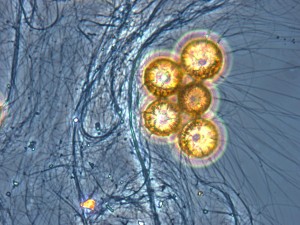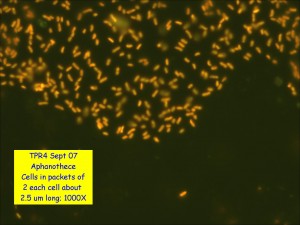Limnological processes occurring in drinking water reservoirs can cause problems for treatment infrastructures. Classic examples involve invasive species, such as zebra and quagga mussels or the recently infamous rock-snot diatom Didymosphenia geminata. But endemic biota can also affect treatment systems. Recently, several drinking water purveyors in the Cascade foothills have encountered issues caused by planktonic organisms.
For example, the City of Everett Filtration Plant experiences intermittent filter clogging from the zooplankter Holopedium gibberum. This zooplankter is common in oligotrophic softwater lakes throughout the Northern Hemisphere; its 2-3 mm gelatinous sheath can clog the pores of drinking water treatment filters. The City of Bellingham experienced severe filter clogging from a series of phytoplankton blooms in 2009 and had to ration water usage that year. The cyanobacteria taxa Aphanocapsa and Aphanothece, which produce extensive mucilage, were implicated in this clogging. The City of Seattle is an unfiltered source, but Seattle’s water system has experienced problems with biofouling by the diatom Cyclotella at their drinking water facility. Cyclotella is usually a beneficial component of lake food webs, but can also produce microfilaments that coat screens and meters, rendering them useless for extended periods. The population dynamics of these taxa are very difficult to predict. Some, like the Holopedium in Lake Chaplain, are in their preferred habitat, but weather and other factors impact year-to-year abundance. The sudden increase in abundance of filter clogging cyanobacteria at Bellingham has been attributed to warmer weather and potential shifts in the trophic state of Lake Whatcom. The sudden advent of Cyclotella in Lake Youngs has not yet been linked to specific environmental factors.
With funds from the Water Research Federation, the Cities of Tacoma, Seattle and Everett, in partnership with HDR Engineering, are investigating species that could disrupt the functioning of drinking water storage and treatment systems. As part of this process, we would like to survey the range of species known to cause problems in Pacific Northwest drinking water supply reservoirs. To share relevant experiences, including solutions you have implemented, please contact project lead Matt McFadden by clicking here.












